 [The death of Robert Frank at the age of 94 in a Nova Scotia hospital on September 9, 2019 will mark the end of an era for many, myself included. In some ways his work bookends my work as a photography critic, at least up to this point.
[The death of Robert Frank at the age of 94 in a Nova Scotia hospital on September 9, 2019 will mark the end of an era for many, myself included. In some ways his work bookends my work as a photography critic, at least up to this point.
When I began publishing my column “Latent Image” in the Village Voice in June 1968, Frank’s germinal 1959 book, The Americans, had gone out of print. Yet its disturbing, disruptive effect had already begun to manifest itself in the contemporary photographic work that I began writing about a decade later. I would end up reviewing the second U.S. edition of The Americans, published by Aperture in 1970.
I got to meet Frank and his wife, the painter and sculptor June Leaf, several times — as when he attended the opening of a retrospective exhibition of the work of Michael Martone that I curated for the gallery of the Department of Photography, Tisch School of the Arts, New York University, in 1986. Frank and I shared a deep respect for this unjustly neglected photographer. I also ended up having a bit part in one of Frank’s lesser films, “Last Supper” (1992).
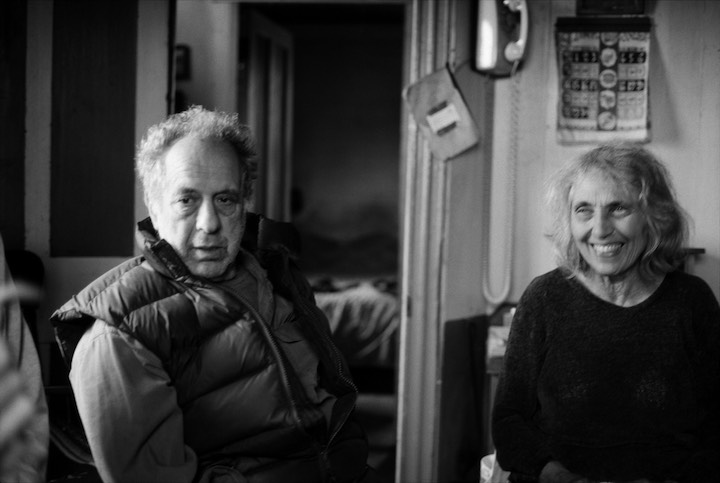
Robert Frank and June Leaf, Mabou, Nova Scotia, ca. 1994. Photo © 2019 by Clark Winter
I had the curious fortune of learning of Frank’s passing from a tearful close friend of his into whose Manhattan apartment I walked that morning expecting to pursue a different professional matter, and to find myself on the phone, a few hours later, with another of his close friends, also sobbing. For a man so inward, and so determinedly reclusive, Robert Frank was much loved — certainly by those who knew him well, but also by many who, like me, knew him only in passing, and thousands more who know only his work and his example.
When I left my friend’s apartment that afternoon I walked past the Astor Place building where Frank and Leaf lived and worked when in New York. People were milling around outside, and flowers and other tributes were already piling up.
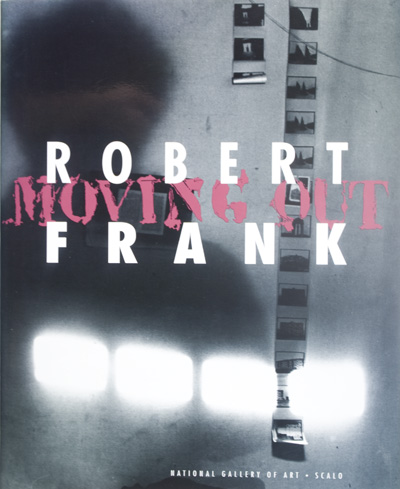
Sarah Greenough and Phillip Brookman, Robert Frank: Moving Out (1995), cover
While Frank became a reference point for me in my early years as a photo critic, as he did for so many others, and gradually turned into a — perhaps the — central figure in my thinking about 20th-century photography, for one reason or another I would not write at length about him until the occasion arose with his 1995 touring exhibition “Moving Out.”
The following review thereof, under the headline “Robert Frank, a Retrospective: The Reluctant Reference Point,” appeared in my column at the New York Observer, December 4, 1995. — A.D.C.]
•
For myself, and for many others, no living photographer occupies a position of greater importance than Robert Frank, no single work resonates more profoundly than The Americans. By choice, this Swiss-born expatriate has produced no extended, unified body of strictly photographic work since The Americans, his first published book, appeared in 1959. Yet, despite a third of a century’s work in film and twenty-five years’ production of photographic objects, that slim volume, which represented and provoked one of the medium’s great paradigm shifts, remains the single creative act for which he’s most widely and immediately recognized.
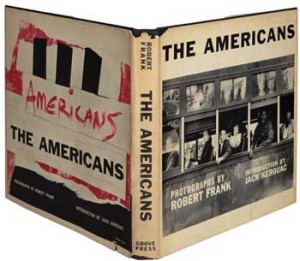
Robert Frank, “The Americans,” first U.S. edition, 1959.
Hence the impossibility of visualizing the photography of the past forty years with Robert Frank absent from it parallels the difficulty of imagining Mr. Frank’s life work with his early achievements in still photography extracted therefrom. The fine retrospective survey “Robert Frank: Moving Out” currently at the Whitney Museum of American Art misses a bet by not including copies of the first French (Delpire) and U.S. (Grove Press) editions of that book — diminutive artifacts that revised assumptions about photography no less drastically than “Waiting for Godot” rewrote the ground rules for theater. However, as this show makes clear, The Americans became an anomaly within Mr. Frank’s oeuvre as his creative life evolved.
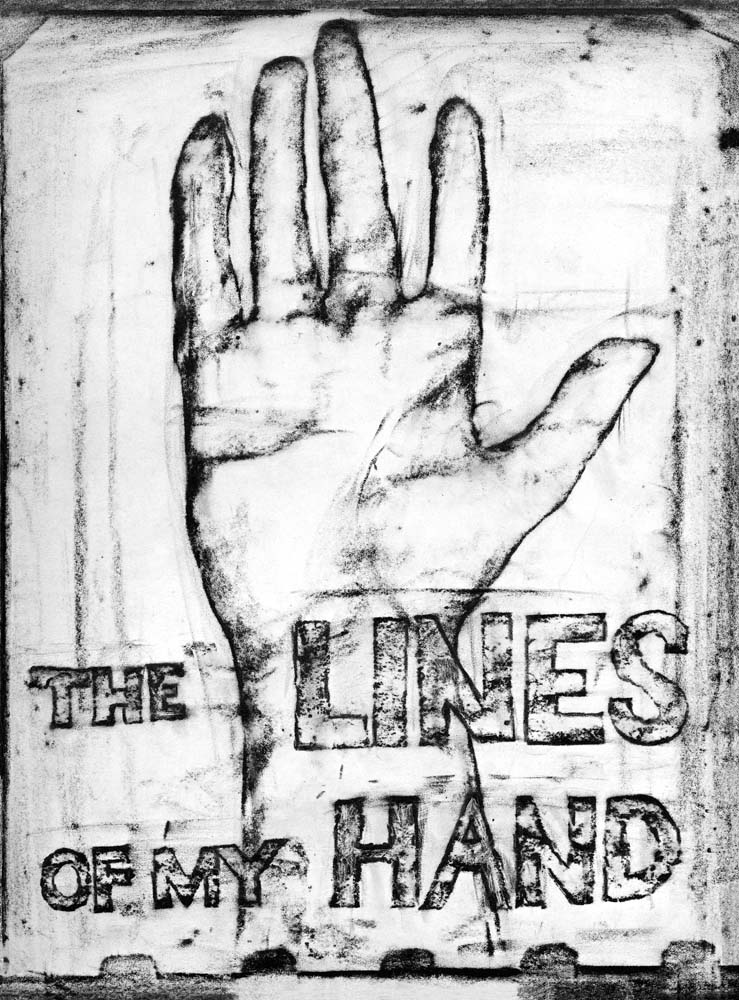
Robert Frank, The Lines of My Hand (cover), 1978
Aside from a 1972 volume, The Lines of My Hand, which I would describe as a contextualizing commentary on that earlier project, he would never again concentrate on the small-camera black & white seeing for which he’d manifested such genius, nor redact still images into extended sequences with such virtuoso skill, nor address the social anomie of this or any other culture with such direct, penetrating insight. Instead, he headed down a more introspective, autobiographical path, especially in his subsequent photographic activity, while devoting his energies to media that proved far less tractable — forms in which his successes have been less evident and less frequent, his performance more inconsistent, his influence (aside from his first film, Pull My Daisy, made with Alfred Leslie) less unavoidable.
Indeed, one subtext of this show, at least in my reading of it, is the extent to which that first book, as a succes d’estime, altered Mr. Frank — or, perhaps more precisely, redefined the context in which he lived and worked — in ways not at all to his liking. That book’s acuteness as sociopolitical critique, its seminal insights into book form and the sequencing of photographs, its innovations in image structure and its display of virtuoso skills in camera handling made the reclusive photographer into a reference point and even something of a celebrity on numerous levels simultaneously.
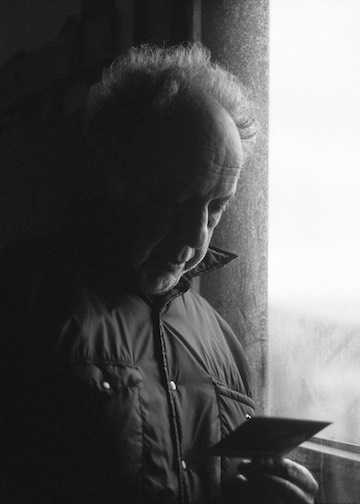
Robert Frank, Mabou, Nova Scotia, ca. 1994. Photo © 2019 by Clark Winter
To say that he did not relish that role in any venue would understate the case; the energy he’s found it necessary to expend in resisting those unexpected consequences has been considerable. As Neil Young sings, “It don’t mean that much to me to mean that much to you.” Mr. Frank has worked very hard to fall back into the pack and persuade everyone, himself included, that his germinal book was really a fluke — or, in any event, that nothing else like it should be expected of him.
•
Somewhere, I once read that among Japanese woodblock artists it was a custom to find and develop a style, bring it to a peak of perfection — and then abandon both the style and the name one had used while working within it, starting over fresh, at the bottom, with no residual fame, nothing to live up to. It’s no coincidence that the Japanese have been among Mr. Frank’s first and greatest fans; there are kinships between the swift brushstrokes of sumi-e painting and the gestural-drawing quality of small-camera photography at its best, exemplified by Mr. Frank’s work. Had he lived in a culture in which changing one’s name was permissible, I think he might have done so; instead, after The Americans, he simply stepped off the stage of classic still photography, never to return.
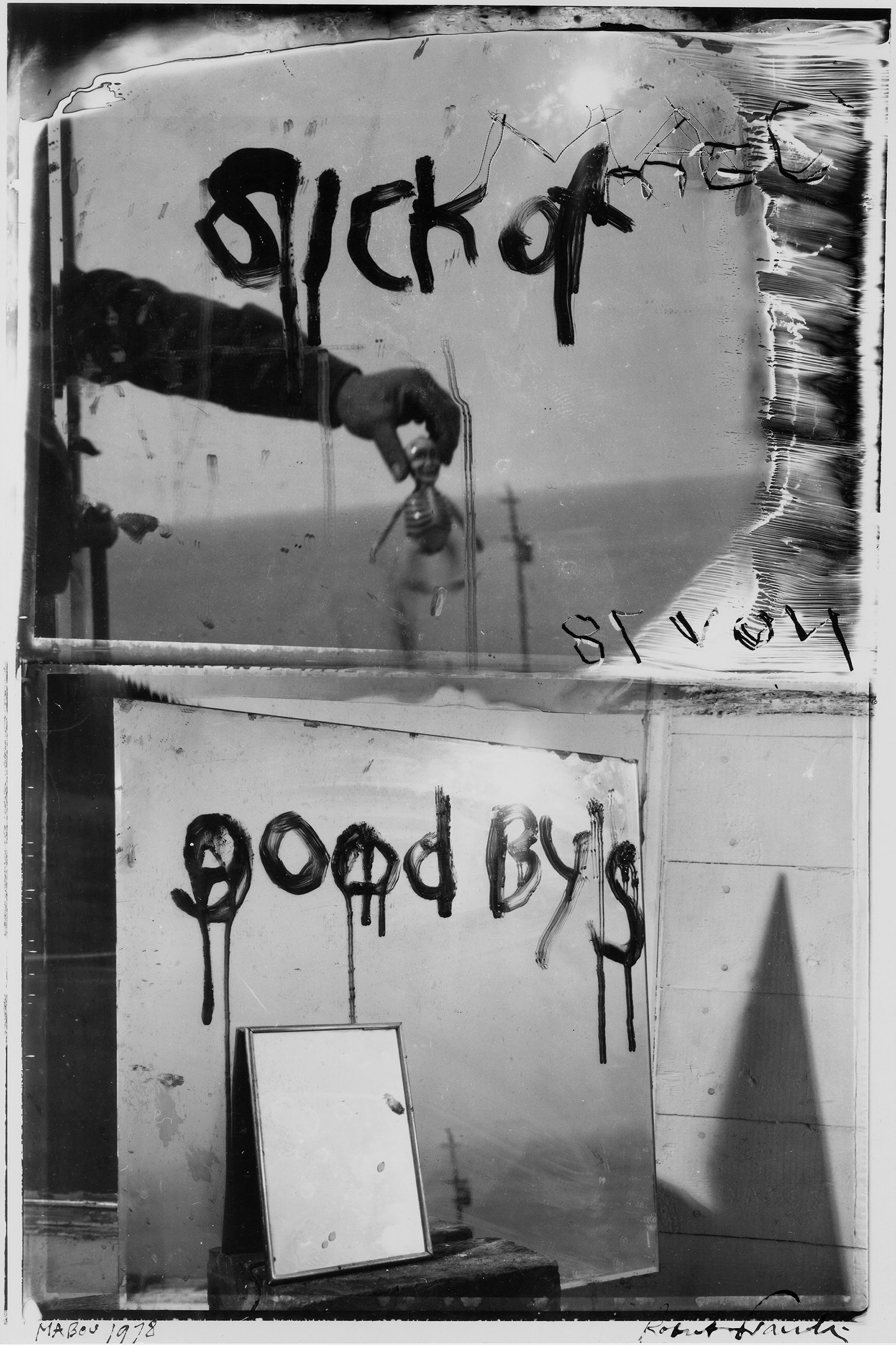
Robert Frank, “Sick of Goodby’s,” 1978 (from The Lines of My Hand)
Yet he cannot get rid of his place in the medium’s history, nor of its place in his life on all levels. This exhibition includes a retrospective of Mr. Frank’s films and videos (for the record, I have a small speaking role in one of these, “Last Supper.”) Among the most notable, and most painful, of these works is “Conversations In Vermont,” in which Mr. Frank and his children speak of the past, using his photographs as memory triggers.
In addition to his inwardness, Mr. Frank makes it clear from his work that he’s haunted by many things, including his own photographs. “Sick of Goodby’s,” reads a photographed scrawl on a mirror from which one of his collages takes its title, and he has said his share of those — most painfully, no doubt, to his daughter Andrea, killed in a plane crash, and his emotionally disturbed son Pablo, dead by his own hand.
•
All of that personal history is embedded within his films, photographs and mixed-media works. I find the assemblages uneven in quality, but never uninteresting, and the best of them have a remarkable potency. In one of the most poignant works in this show, an untitled assemblage from 1989, two clusters of photographs coexist. The bottom half consists of a collage of some 20 fading thermal-transfer prints, in one of which the words “Haunted to death” can be clearly read. Above them, bound in copper wire and literally nailed to the backing board, there’s a thick stack of silver-gelatin prints, presumably all the photographer’s own images. On top is an image of his made in Spain, in 1950, at a bullfight. In the foreground stands a bull, seen from behind and above, a matador’s sword plunged deep into his back. It sticks out at an angle — a bungled thrust, perhaps not even fatal. Yet he’s dead already. Beyond him, slightly out of focus, we see bullfighters’ legs and hands, gestures suggesting shoptalk, the business of the kill. In this context, it feels like a self-portrait, with the bull standing in for the photographer. In the collage underneath, Mr. Frank looks out at you, as you look through his eyes at the bull, and at him.
•
Another difference between The Americans and everything that came after is the shift it represents from clarity and precision to messiness. The photographer took a full year to redact that work, winnowing 83 images out of approximately 20,000, organizing them into a structure so complex and tight that even the reversing of two images shifts the meaning. The photographs in The Americans lay out the future of this country with the inexorability of a fortune-teller dealing out the Tarot. There’s not a replaceable picture in the entire statement, not a note out of place, nary a slip in the rhythm. This is as close to perfect as anyone in photography had come in constructing a bookwork — more so, even, than Walker Evans’s American Photographs, which had influenced it considerably.
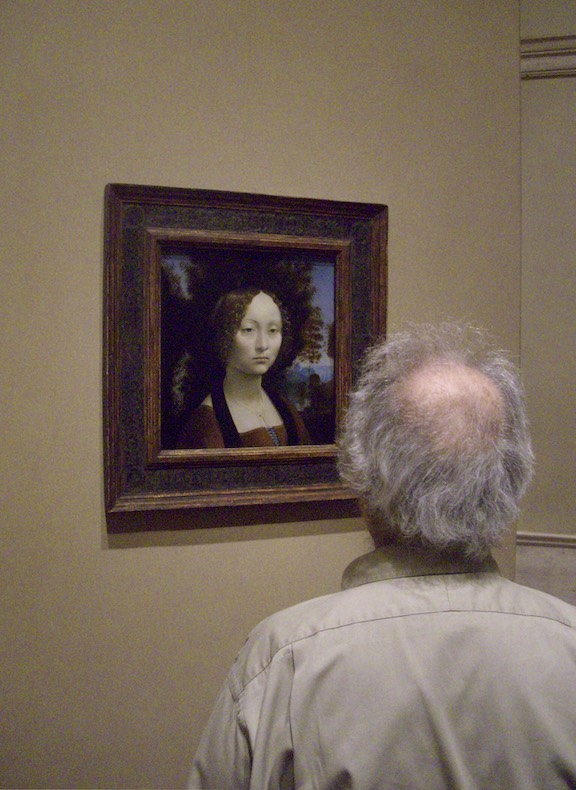
Robert Frank contemplating Da Vinci portrait, National Gallery of Art, Washington, DC, March 24, 2009. Photo © 2019 by Clark Winter
Something about that, I think, bothered Mr. Frank. From the evidence of everything since, he’s drawn to open forms, loose ends, a sense of the homemade and handmade, the occasional slipped stitch, a story that goes on a bit too long, a stewpot with food baked onto its sides, typescript instead of print. Looking at the Whitney’s concurrent show, “Beat Culture and the New America, 1950-65,” one can see his obvious kinship with Beat attitudes, part of which was a rebellion against the paralyzing neatness of U.S. culture. Mr. Frank must have empathized particularly with that tendency, coming from Switzerland, an even more hidebound country. (My favorite Swiss joke: Why don’t the Swiss steal? Because it’s forbidden.)
•
If Mr. Frank could not escape our awareness of him as the maker of The Americans, he certainly has refused to rest on that laurel, and doggedly resisted our defining him by it. He’s made any attempt to place him on a pedestal or elevate him to a pantheon as difficult as any major artist I know of, past or present. He has found ways of making his discomfort with his stature ours, using our reverence for The Americans and our respect for him against us not sneeringly but subversively, demanding that we come to terms with him, and ourselves, always in the present, in the now.
In that intransigence he joins Jack Kerouac (who wrote the introduction for the U.S. edition of The Americans) and the other Beat writers and artists who formed his cohort — and the visionaries, jazz musicians and Zen philosophers from whom they drew inspiration — in refusing to distinguish between art-making and living, and insisting on approaching both as process rather than product. Surely he has kept the faith.
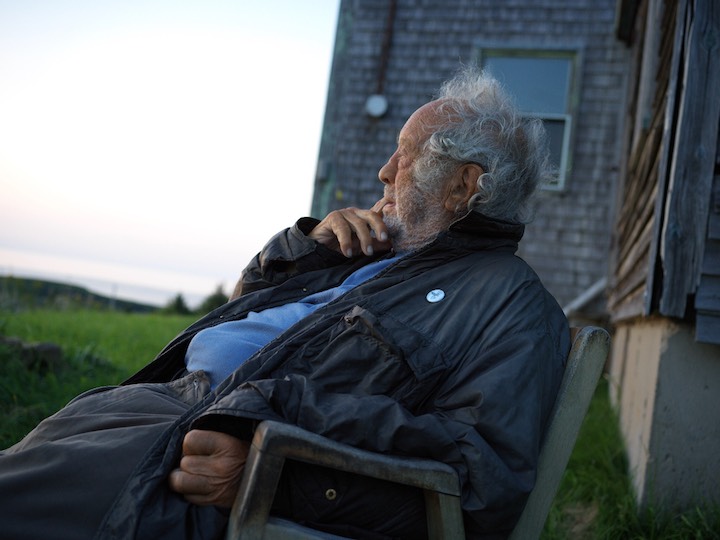
Robert Frank, Mabou, Nova Scotia, 2018. Photo © 2018 by Clark Winter
Organized by Sarah Greenough of the National Gallery of Art and Philip Brookman of the Corcoran Gallery of Art, this show is drawn in large part from a major collection of Mr. Frank’s work now in the holdings of the National Gallery, where the retrospective made its debut a year ago. Twenty-three films and videotapes will be screened during its stay at the Whitney. This will enable the New York audience to start coming to terms with the totality of the output of this 71-year-old artist, perhaps at long last putting his early achievement in context — and in perspective.
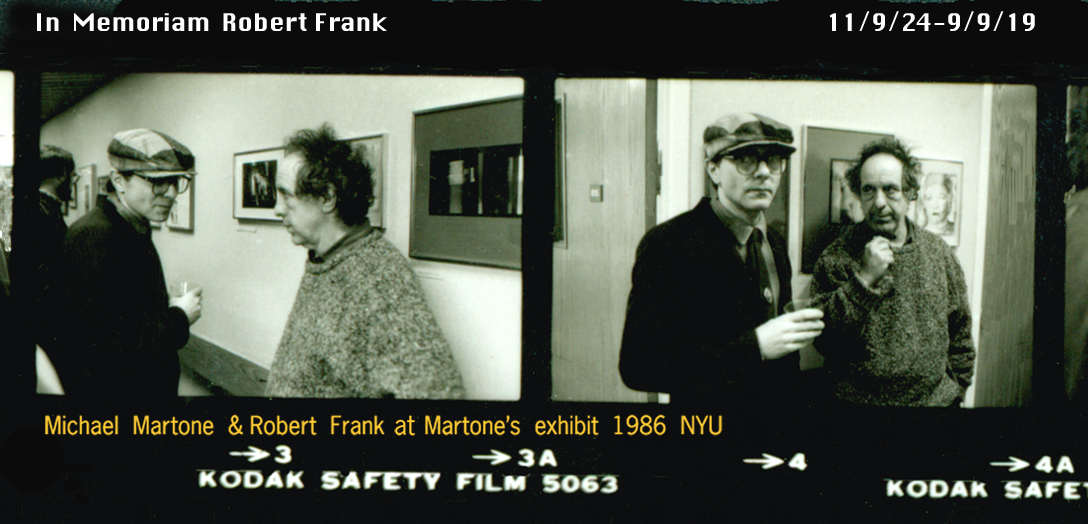
Robert Frank at Michael Martone retrospective, Tisch School of the Arts, NYU, 1986. Photographer unknown.
•
This post sponsored by a donation from photographer Bill Krumholz.
•
Special offer: If you want me to either continue pursuing a particular subject or give you a break and (for one post) write on a topic — my choice — other than the current main story, make a donation of $50 via the PayPal widget below, indicating your preference in a note accompanying your donation. I’ll credit you as that new post’s sponsor, and link to a website of your choosing.
 Include a note with your snail-mail address (or email it to me separately) and I’ll include three (3!) copies of The Silent Strength of Liu Xia, the catalog of the 2012-13 touring exhibition of photos by the dissident Chinese photographer, artist, and poet, who, after eight years of extralegal house arrest in Beijing, finally got released and expatriated to Germany in 2018. The only publication of her photographic work, it includes all 26 images in the exhibition, plus another 14 from the same series, along with essays by Guy Sorman, Andrew Nathan, and Cui Weiping, professor at the Beijing Film Academy. Keep one for yourself, share the others with friends.
Include a note with your snail-mail address (or email it to me separately) and I’ll include three (3!) copies of The Silent Strength of Liu Xia, the catalog of the 2012-13 touring exhibition of photos by the dissident Chinese photographer, artist, and poet, who, after eight years of extralegal house arrest in Beijing, finally got released and expatriated to Germany in 2018. The only publication of her photographic work, it includes all 26 images in the exhibition, plus another 14 from the same series, along with essays by Guy Sorman, Andrew Nathan, and Cui Weiping, professor at the Beijing Film Academy. Keep one for yourself, share the others with friends.






Consonant with ADC’s 1995 review, the transcript of Robert Frank speaking at Wellesley College in April 1975 is a crucial resource for understanding Frank’s intentions, both before and after his creation of “The Americans”. That transcript – first published in the 1977 book “Photography Within the Humanities” – belongs in every photography historian’s library. And the library of anyone trying to understand the miracles that are “American Photographs,” “The Americans,” and the relationship between Walker Evans and Robert Frank.
https://archive.org/details/photographywithi00well
Thank you for a beautifully written post on the influence of Frank and Leaf, from a personal, professional, and friendship perspective.
Thanks for this fine tribute and review. I am brought closer in heart and mind to the rawness of the work of this self-reflective human being, Robert Frank, and sit up to honour him as deeply a part of my my own life and work. These words resonate:
“In that intransigence he joins Jack Kerouac (who wrote the introduction for the U.S. edition of The Americans) and the other Beat writers and artists who formed his cohort — and the visionaries, jazz musicians and Zen philosophers from whom they drew inspiration — in refusing to distinguish between art-making and living, and insisting on approaching both as process rather than product. Surely he has kept the faith.”
Excellent article as always. Wish I had seen the retrospective at the Whitney, way back in ’95.
It is odd that as undeniably one of the key figures of the 20th century photography, his work has been so elusive internationally. Other than a couple of his later prints viewed at a commercial gallery in NYC, and a few (fascinating) contact sheets from The Americans included in a group exhibition at the Tate Modern a few years back, I haven’t had the privilege of seeing his work up close. Meanwhile I have been tripping over Eggleston’s work wherever I go for the past 5-10yrs …
I’m not au courant regarding presentations of Frank’s work outside the U.S. But certainly his German publisher Steidl has done everything possible to make the work, in its totality, as available as possible everywhere.
Had never heard that profound Ukiyo-e story before, apt, insightful element in your piece. The sumi-e reference pretty nice too. Makes me think of when Miles produced Bitches Brew, and I remember the booing at a Dylan concert years ago when he went electric – surely there is a book to be made about artists’ self-reinvention.
Actually, my positing that probably means it’s been done.
I think we crossed paths at an elevator at his NYU show a few years ago where Robert responded to the pitiful question of what he was working on now: “getting home and going to bed.”
Good to read, thanks.
David
I remember bumping into you at that show — a terrific exhibition, I should add, brilliantly conceived. I have kept thinking about it ever since, should probably post a belated review.
By my lights, Gerhard Steidl has proved himself everything that one could want as a publisher for Frank, and a publisher for us, intent on making everything available at affordable prices.
But that interview of his with Robert that night — which I watched on video later — just embarrassed me for him. I recall one convoluted question about why Frank left Switzerland, posited as inquiring why RF didn’t choose to stay and work in his uncle’s bicycle shop. Strained, awkward, and too clever by far.
A number of the newspaper obits of Frank maintain that The Americans received a hostile reception when it was published in 1958. It was allegedly perceived as anti-American. Some articles cited a review in Pop Photo. I’m suspicious that this was typical of the book’s reception. When I learned of the book in a photography class in 1965 every serious photographer loved it. A suggestion for a term paper in a class in photo-criticism: a brief history of the book’s critical reception.
I don’t have access to my library at the moment, but I seem to recall that the 1986 monograph “Robert Frank: New York to Nova Scotia” (reprinted in 2005 by Steidl), the catalog of a retrospective exhibition organized by the Museum of Fine Arts, Houston, and the 2009 study of that key bookwork, “Looking In: Robert Frank’s The Americans,” both address at some length the critical reception of Frank’s book. The same likely holds true for “Robert Frank: In America” (2014) by Peter Galassi, with which I’m not familiar.
I do recall that “New York to Nova Scotia” has at least one full page of extracts from the reviews, which were almost without exception negative if not downright hostile. Most, I should add, came from what we might call the photo press (Popular Photography et al); if memory serves, the more general-audience publications largely ignored it, as they did with most photo books.
Anyhow, your imaginary student wouldn’t have to start from scratch (nor would you, if you truly want to pursue this); the bibliographies of those three volumes alone should serve as jumping-off points.
Since photographers, then as now, no matter how literate and articulate, rarely bring themselves to make public statements about anything, even in defense of work they admire greatly, those who understood what Frank had achieved largely kept mum about their respect for him, at least on the record. So the fact that you knew some number back then who valued this work privately has no relation whatsoever to what got published about it, except perhaps in inverse proportion.
Perhaps if they’d troubled themselves to speak up on behalf of Frank at the time, the book’s reception at the time would look much different in retrospect. Who knows? Could be a lesson in there for someone.
Greetings – A.D thanks for the memorial note on Robert Frank what a Man beyond words now has gone home to be with his Children – Artist -Peter Herley
To A.D. and A. David Wunsch. My master’s thesis for the University of Arizona in 1986 was about the critical reception of The Americans in all of the editions up to that date and about the establishment of Frank’s reputation. In the same year my comprehensive bibliography of 2,200 annotated references was co-published by the Cecnter for Creative Photography and the Museum of Fine Arts, Houston so there is a good bit more to go on than the bibliographies in the three retrospective catalogues. I continue to gather obscure reviews from the early years. Positive reviews of the book do exist but they were drowned out by the multi-author attack from Popular Photography magazine.
I should add that at the time The Americans first came out in this country (1959) photography had no working critics. The lack of platforms for commentary on the medium — aside from the camera mags like Pop Photo and the thin ranks of “little” magazines devoted to the medium (aperture, Contemporary Photographer, Infinity) — compounded the problem.
To the credit of U.S. Camera and its editor, Tom Maloney, that annual ran an unusual insert with Frank photos and supportive commentary (by Walker Evans) after the French edition came out in 1958 and before the U.S. edition did. That’s the most prominent affirmation of what Frank had achieved that I know of in this country from the work’s early days.
Ten years later, when the second edition came out, the situation hadn’t changed much. I had launched my column in the Village Voice, but that was about it. Sadly enough, after a brief flourishing the medium is pretty much back to where it was 50 years ago in terms of critical response in mainstream publications.